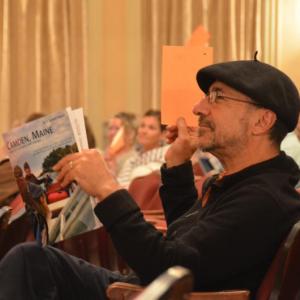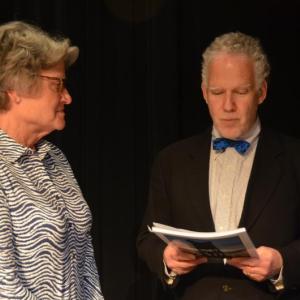Camden citizens address fixing aging infrastructure, and borrowing, interest-free, from themselves
 Camden resident Pete Kalajian votes yes at the annual Camden Town Meeting, held June 12, 2019, at the Camden Opera House. (Photo by Lynda Clancy)
Camden resident Pete Kalajian votes yes at the annual Camden Town Meeting, held June 12, 2019, at the Camden Opera House. (Photo by Lynda Clancy)
 Approximately 60 Camden residents turned out for the 2019 annual town meeting held June 12 at the Camden Opera House. (Photo by Lynda Clancy)
Approximately 60 Camden residents turned out for the 2019 annual town meeting held June 12 at the Camden Opera House. (Photo by Lynda Clancy)
 Camden Select Board at its first meeting of the new fiscal year: Alison McKellar, Taylor Benzie, Bob Falciani, Marc Ratner, Jenna Lookner and Town Manager Audra Caler- Bell. (Photo by Lynda Clancy)
Camden Select Board at its first meeting of the new fiscal year: Alison McKellar, Taylor Benzie, Bob Falciani, Marc Ratner, Jenna Lookner and Town Manager Audra Caler- Bell. (Photo by Lynda Clancy)
 Camden Town Meeting Moderal Deb Dodge. (Photo by Lynda Clancy)
Camden Town Meeting Moderal Deb Dodge. (Photo by Lynda Clancy)
 Town Meeting Moderator (and former Select Board member) with current Select Board member Alison McKellar. (Photo by Lynda Clancy)
Town Meeting Moderator (and former Select Board member) with current Select Board member Alison McKellar. (Photo by Lynda Clancy)
 Select board members Alison McKellar and Jenna Lookner. (Photo by Lynda Clancy)
Select board members Alison McKellar and Jenna Lookner. (Photo by Lynda Clancy)
 Select Board members Marc Ratner and Jenna Lookner with Town Manager Audra Caler-Bell. (Photo by Lynda Clancy)
Select Board members Marc Ratner and Jenna Lookner with Town Manager Audra Caler-Bell. (Photo by Lynda Clancy)
 Select Board Chairman Bob Falciani congratulates Marc Ratner on his reelection. (Photo by Lynda Clancy)
Select Board Chairman Bob Falciani congratulates Marc Ratner on his reelection. (Photo by Lynda Clancy)
 Town Meeting Moderator Deb Dodge swears in Marc Ratner for another term on the Select Board. (Photo by Lynda Clancy)
Town Meeting Moderator Deb Dodge swears in Marc Ratner for another term on the Select Board. (Photo by Lynda Clancy)
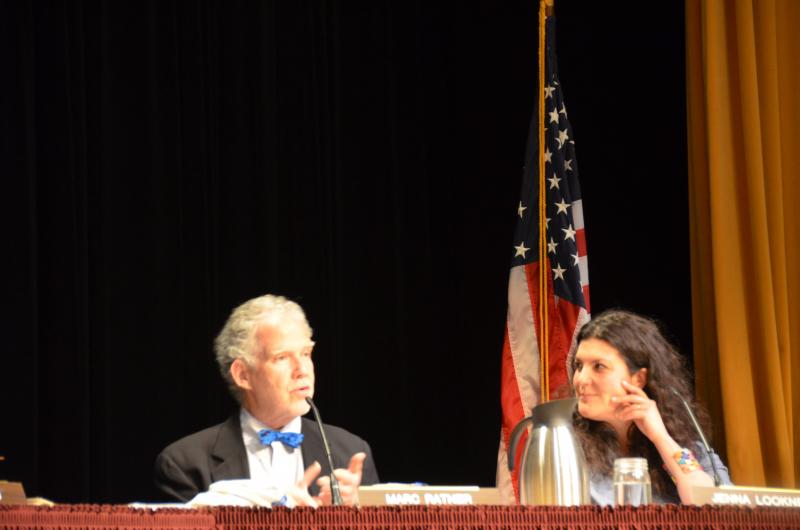 Select board members Marc Ratner and Jenna Lookner. (Photo by Lynda Clancy)
Select board members Marc Ratner and Jenna Lookner. (Photo by Lynda Clancy)
 Camden resident Pete Kalajian votes yes at the annual Camden Town Meeting, held June 12, 2019, at the Camden Opera House. (Photo by Lynda Clancy)
Camden resident Pete Kalajian votes yes at the annual Camden Town Meeting, held June 12, 2019, at the Camden Opera House. (Photo by Lynda Clancy)
 Approximately 60 Camden residents turned out for the 2019 annual town meeting held June 12 at the Camden Opera House. (Photo by Lynda Clancy)
Approximately 60 Camden residents turned out for the 2019 annual town meeting held June 12 at the Camden Opera House. (Photo by Lynda Clancy)
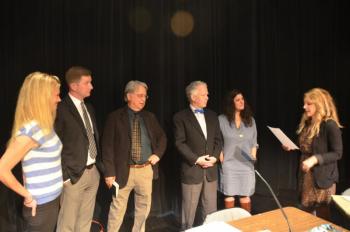 Camden Select Board at its first meeting of the new fiscal year: Alison McKellar, Taylor Benzie, Bob Falciani, Marc Ratner, Jenna Lookner and Town Manager Audra Caler- Bell. (Photo by Lynda Clancy)
Camden Select Board at its first meeting of the new fiscal year: Alison McKellar, Taylor Benzie, Bob Falciani, Marc Ratner, Jenna Lookner and Town Manager Audra Caler- Bell. (Photo by Lynda Clancy)
 Camden Town Meeting Moderal Deb Dodge. (Photo by Lynda Clancy)
Camden Town Meeting Moderal Deb Dodge. (Photo by Lynda Clancy)
 Town Meeting Moderator (and former Select Board member) with current Select Board member Alison McKellar. (Photo by Lynda Clancy)
Town Meeting Moderator (and former Select Board member) with current Select Board member Alison McKellar. (Photo by Lynda Clancy)
 Select board members Alison McKellar and Jenna Lookner. (Photo by Lynda Clancy)
Select board members Alison McKellar and Jenna Lookner. (Photo by Lynda Clancy)
 Select Board members Marc Ratner and Jenna Lookner with Town Manager Audra Caler-Bell. (Photo by Lynda Clancy)
Select Board members Marc Ratner and Jenna Lookner with Town Manager Audra Caler-Bell. (Photo by Lynda Clancy)
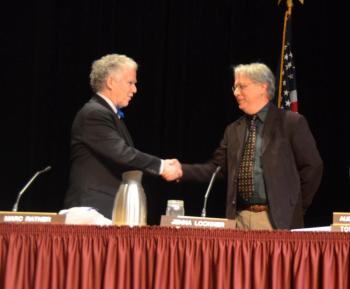 Select Board Chairman Bob Falciani congratulates Marc Ratner on his reelection. (Photo by Lynda Clancy)
Select Board Chairman Bob Falciani congratulates Marc Ratner on his reelection. (Photo by Lynda Clancy)
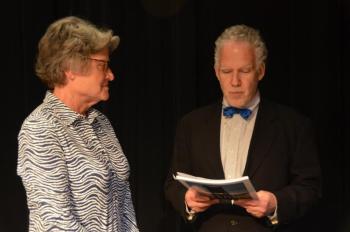 Town Meeting Moderator Deb Dodge swears in Marc Ratner for another term on the Select Board. (Photo by Lynda Clancy)
Town Meeting Moderator Deb Dodge swears in Marc Ratner for another term on the Select Board. (Photo by Lynda Clancy)
 Select board members Marc Ratner and Jenna Lookner. (Photo by Lynda Clancy)
Select board members Marc Ratner and Jenna Lookner. (Photo by Lynda Clancy)
CAMDEN — Infrastructure spending and questions about financing it all dominated discussion at Camden’s 2019 Town Meeting, held at the Camden Opera House, June 12. The annual gathering of citizens to consider how to spend taxpayer money over the next year drew approximately 60, and was over in one hour. Their questions ranged from how the town will deal with expenses, as well as climate change and the current scourge of brown tail moths and other pests.
By meeting’s end, Camden citizens had agreed to endorse a $9.7 million 2019-2020 budget for the town that includes operational costs of running a police and fire department, town office and public works, as well as dam repairs, roadwork, and putting money aside to eventually close the Midcoast Solid Waste landfil.
Voters also approved appropriating $3.7 million from non property tax revenue to reduce the property tax burden on taxpayers. (Read the entire 2019 June town meeting warrant here)
The day prior, 551 Camden voters (“not a record,” commented Town Meeting Moderator Deb Dodge), had gone to the polls and cast ballots for reelecting Marc Ratner to the Select Board, and Rebecca Flanagan and Peter Orne to the SAD 28 and Five Town CSD school boards. They also approved the school budgets and five ordinance amendments.
(Read: Camden voters endorse new marijuana rules, littering and food ordinances)
On June 12, the town then resumed its annual town meeting business at the Opera House, picking up on Article 8 of a warrant that totaled 22 articles.
Camden’s Select Board — Taylor Benzie, Alison McKellar, Chairman Bob Falciani, Marc Ratner and Jenna Lookner — sat on the stage, along with Town Manager Audra Taler-Bell. Moderator Dodge opened the meeting with a report to the citizenry about the June 11 poll results.
She asked the public to stand and recite the pledge of allegiance, and then thanked the town staff for organizing and presenting the two-day annual town meeting, citing: “Deputy Moderator Beth Ward, Registrar Elaine Davis, and all 12 of the ballot workers; Chief Farley and his crew for setting up the polls and taking them down; a special thanks to Katrina Oakes, our town clerk, and Kendall Espinosa, our deputy town clerk. They worked days in advance to get ready and 12 hours yesterday to make sure everything went smoothly; and Dave and Juniper for getting the Opera House ready tonight.”
Chairman Bob Falciani also read the dedication of the 2019 Camden Town Report, which honors former Select Board member John French for his contributions — past and ongoing — to the town.
The town also remembered two dedicated citizens, Sidney Lindsley and Frank Stearns.
See attached PDFs for the dedication and remembrances.
After reading the dedication, those attending town meeting gave French a rousing applause.
Dodge then lead the town through the 2019 June warrant, with the first article to engender conversation having to do with disposing of tax acquired property, “except that the Select Board shall use the special sale process required [by state law] for qualifying homestead property if they choose to sell it to anyone other than the former owner,” excluding the Tannery property, which carries its own sale guidelines and whose sale would require a town vote.
John French asked what had changed in the wording of this article, which crops up every year on the town warrant.
Dodge replied that the inclusion of the homestead language has been added, reflecting changes to the state law, which requires a special disposition procedure for properties acquired through liens that were owned by the elderly.
“So they [the town] still have a right to put it to bid,” asked French.
“Yes,” said Dodge. “This is for homestead property.”
Town Attorney Bill Kelly then clarified: “It’s an added protection for people 65 and older” in the sale of their properties that were acquired by the town through tax liens.
Camden resident Roger Rittmaster asked about Sagamore Farms and whether the 70-acre parcel could be sold by the Select Board, saying that its size and importance should be considered by the voters of Camden if it were to be pegged for sale.
Dodge asked, “Was the Sagamore Farm acquired through tax liens.”
“It was,” said Falciani.
McKellar clarified that in 1946 it was given in lieu of taxes. She added that technically, it would fall under the stipulations of warrant article 10 under discussion.
Dodge then called for a vote, and the article passed with 5 voting no.
The town then talked about Article 13, which asked citizens to approve replacing the gate and structural support beams at the West Dam, for $290,000, to be paid from the town’s unassigned fund balance, and “to be paid back over the next 10-15 years.”
The town report noted that the total town debt load as of June 30, 2018 was $27 million, with $4.3 million of municipal debt, $285,120 worth of county debt and $23 million in school debt.
The cost of the inter-fund borrowing of $290,000 from unassigned fund balance for the dam repair, according to the town, would accrue no interest.
French said: “I know you want a total of about $1 million for several different projects,” to Town Manager Audra Caler-Bell. “One was $360,000, the other $400,000. And they want to borrow and pay it back over a 10-year period, at no interest. But we are still going to see a budget impact on the tax rate, with payments over the next 10 years. I thought we had enough in the surplus to just pay for it instead of impacting future tax rates with the payments.”
Those other projects French referenced had to do with taking $265,000 of tax increment financing revenues from the downtown and highway TIF districts to partially offset the Knowlton Street parking lot/lease/purchase, the Route 1 South pedestrian project, seawall restoration, Opera House repairs, as well $360,000 to repair drains and roads from Park Street to John Street, and along Pearl Street.
Caler-Bell responded that the town could, as it normally does, take out a bond to cover the infrastructure repair costs.
“However, unassigned fund balance is so healthy that we have available cash flow to lend to ourselves,” she said. “The reason we are suggesting doing that is because having that money on hand is going to be important in the future. We are in a good position financially as a town now, where we have good cash flow. We don’t have to do any tax anticipation note borrowing. We are buffering ourselves if there is a recession; and if we don’t want to cut services but we don't want to impact taxpayers. There are myriad other emergencies we could face in the future that we want to make sure there is some of this surplus we have built up.”
With the inter-fund borrowing, the town will save $110,000 that would otherwise be paid in interest fees to a bank, if the town had bonded out its infrastructure costs, she said.
Camden resident Ray Andresen asked if there were other six-figure projects on the horizon for next year that would require similar votes.
“The dams continue to surprise us as they have aged,” said McKellar.
She said major expenses with dams may be on the horizon, while Falciani referenced the town’s capital plan, which includes a number of projects with six-digit price tags.
“The idea is to level-ize that and maintain our tax increase to a nominal level,” he said. “How to fund it, as John mentioned? We have to be creative and smart. The funding mechanism that Jodi [Hanson] and Audra came up with is sound fiduciary responsibility. It gives us the flexibility and cash flow. We don’t know what’s going to happen tomorrow.”
Caler-Bell said the capital plan repairs total $28 million to $30 million.
Pate Kalajian asked if the infrastructure conversations and review processes allowed for “vetting in the light of climate change and the projected impacts of water movement, as well as sea level and temperature rise.”
Caler-Bell responded that the seawall at harbor park has eroded thanks to higher ocean levels and that the town has started re-imagining the area, including the public landing.
“This is probably going to be a rolling $28 to $30 million list,” said Falciani, saying, “we have to take into consideration what is going on in the world, in parallel.”
McKellar added that grant funding is available for repairing infrastructure in the interest of sustainability, resiliency and habitat protection.
The article then passed.
Steve Milchesky asked if there is a longterm plan for drainage across town, describing how the drainage system is failing on some streets.
“Those issues are on everyone’s radar,” said McKellar.
Caler-Bell said that encouraging runoff and storm water to be absorbed in a more natural way and understanding its path more is now being addressed — “with dealing with storm water more holistically,” said said, “instead of a street by street approach.”
Chip Laite asked whether the drainage studies from the 1970s have been taken into consideration. That study included the size of culverts and the drainage plan itself.
“That is such a good point,” said McKellar. “I am amazed at all the studies that have been done.”
Falciani said: “Most of those reports were written in a time period when drainage was different, to the point that cities and towns are now looking at permeability.”
“Impermeability has to be replaced with permeability, going forward,” he said. “It is not going to be easy but it is what we have to do.”
By meeting’s end, the town had approved its $9.7 million budget, all warrant articles, praised its town manager, elected Bob Falciani to another year a chairman of the Select Board, and voted to reduced the tax burden on taxpayers by appropriating $3.7 million from non property tax revenue.
The town also entered a brief discussion with a concerned resident about bugs, pests and brown tail moths.
He had asked the Select Board what the property owner might expect in help from the town.
“Spray,” he asked.
That earned a rumble of disapproval from the citizens.
“No spraying,” the man, said, acknowledging the sentiment of the room.
To the conversation about moths and pests, Caler-Bell said the topic would be discussed at the next Select Board meeting, June 18.
Reach Editorial Director at Lynda Clancy@penbaypilot.com’ 207-706-6657
Event Date
Address
United States

